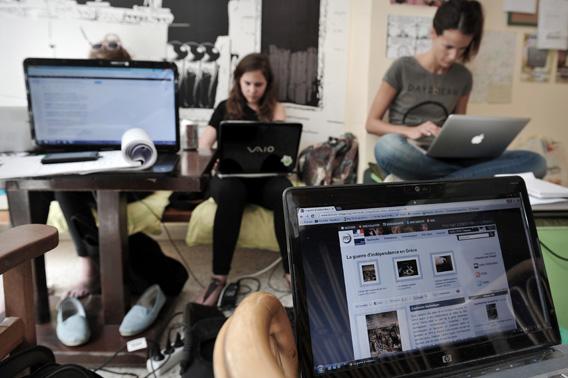Seussian Software
By J. D. BIERSDORFER
Published: May 10, 2013
Judging by the frequent sight of youngsters grabbing for Mom’s
smartphone at the table and toting Dad’s tablet on car trips, it’s a
safe assumption that touch screens have captured the attention of many
children. But for parents (or grandparents) overwhelmed by the abundance
of age-appropriate software, it helps to look for familiar faces in the
crowd. Several internationally popular 20th-century children’s book
characters have expanded beyond the confines of the printed page into
the world of apps.
"The 500 Hats of Bartholomew Cubbins"
"Miffy's Garden"
"The Book About Moomin, Mymble and Little My"
Originally published in 1938, The 500 Hats of Bartholomew Cubbins,
by Dr. Seuss ($4.99) celebrates its 75th anniversary with a
touch-friendly interactive picture book. Intended for children ages 6 to
12, the app is available for iOS and Android devices, and for the
Amazon Kindle and the Barnes & Noble Nook color tablets.
The plot remains the same: A young boy tries to take off his hat to
honor the king, only to have a new one appear repeatedly on his head.
While some children’s apps tend to pile on visual stimulation and
techno-bells-and-whistles at the expense of storytelling, the digital
version of “500 Hats” uses the original Seuss artwork as a solid
foundation and then layers on simple touches that don’t distract from
the reading experience. Sound effects — sheep at the Cubbins homestead, a
trumpet fanfare, the shriek of the Yeoman of the Bowmen — and a gentle
pan-and-zoom focus on the illustrations all accent the narrative as the
reader finger-swipes through each page.
“500 Hats” offers three ways to follow Bartholomew’s misadventure. For
younger children, the “Auto Play” feature automatically moves through
the pages like a video, together with a narrated text. The “Read to Me”
option provides audio narration at the child’s own pace and highlights
each word as it is pronounced. The “Read It Myself” setting is basically
a manual mode that lets the reader assume full control of the pages
without audio prompting.
The “500 Hats” app is just one of dozens of Seussian software programs
for phones and tablets, so those looking for the familiar stories of the
Sneetches, the Grinch, the Lorax, the Cat in the Hat and a certain
emerald-hued breakfast combo can find them all at www.oceanhousemedia.com. Book apps are for sale, as are games featuring the beloved characters.
Games are also available for fans of the Moomins, Tove Jansson’s
wide-eyed hippopotamus-like creatures that first appeared in Sweden in
1945. “Moomin Party” and “Moomin Costume Party” are among the Moomin
apps for Android and iOS in the Google Play and Apple App Store; both
games are free to play at the basic levels. While the games offer a
colorful diversionary slice of Moomin life, parents looking to introduce
their children to Jansson’s original work may want to explore the
interactive edition of her 1952 illustrated story The Book About Moomin, Mymble and Little My. The $2.99 app is designed for the iPad, iPhone and iPod Touch and rated for children age 4 and older.
Children can hear the book read aloud by the English actor Samuel West,
or can test their own reading skills as they follow young Moomintroll’s
quest to get home with a jug of milk through the forest (and past other
obstacles like a large vacuum cleaner). The book’s text can be summoned
or dismissed with a tap; temporarily hiding the words lets one
appreciate Jansson’s artwork with its expressive characters and simple
backgrounds that bring to mind Matisse’s paper cutouts.
Small bits of animation, like a lizard crawling up a tree or raindrops
falling, keep this book of “Moomin” from feeling like a static
adaptation of the printed edition. Tapping on various screen objects
like an owl or the wormlike Hattifatteners brings a reaction, as does
tilting the screen, but none of it pulls too much attention away from
the story at hand.
Dick Bruna, the creator of Miffy the rabbit, has cautioned against
adding too much digital whiz-bang to children’s book apps. “I wouldn’t
want too much interactivity — something to do on every page for instance
— as I think that would make it too complicated for a young child,”
Bruna told The Guardian of London last year.
True to his vision, the app edition of Miffy’s Garden is fairly
straightforward, but does offer a few on-screen activities interspersed
between the pages — perhaps just enough to keep squirmy toddlers
engaged. As Miffy digs and rakes her garden soil in preparation for her
carrot crop, the young reader gets the chance to mimic her actions with
fingers on an adjacent screen. Audio narration is provided in both Dutch
and British-accented English. Still drawn in the same style, with thick
outlines and bold primary colors, the animated Miffy (who first
appeared in 1955) ambles between screens and wields her garden tools,
but the app still feels like a book instead of a video.
So as not to interfere with reading, games are included as separate features. The iPad version
sells for $3.99 and includes more games — and the ability to record
your own voice reading the text — than does the $1.99 edition for iPhone/iPod Touch. Other Miffy apps are also available, all rated for children 4 years and older.
While the slick digitized edition of a longtime family favorite can’t
really replace the comforting feel of a well-worn printed book being
read in a warm lap, the app versions do provide additional opportunities
for children who want to hone their reading skills on their own. And
the classics never go out of style, no matter the format.


















